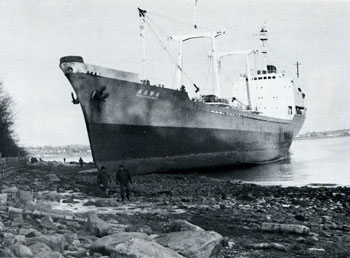The Musashino Maru

The Japanese freighter Musashino Maru aground at Searsport, Maine, on February 2, 1976. There were heavy rains and high winds and visibility was limited. Her bottom was holed by the rocks. Photo by Bob Beattie.
The modern cargo ships are equipped with all of the latest aids to navigation. They are not easily run aground, but high winds and adverse circumstances sometimes change the rules. The Japanese freighter Musashino Maru was grounded near Searsport during a severe coastal storm on February 2, 1976. The vessel arrived light and was blown ashore on Moose Point at 5:30 a.m. by hurricane force winds. The 362-foot refrigerator ship sprang a leak in a fuel tank resulting in 150 to 200 gallons of oil being spilled along the shore. The ship was to have loaded fifteen thousand tons of frozen french fried potatoes for shipment to the United Kingdom. As she came ashore during an abnormally high tide, they had to wait for two weeks for another such tide before they could attempt to refloat her. In that time the ship became a major sight-seeing attraction. At time, there were one hundred automobiles parked along Route 1 in Searsport. People crossed over private property to see the grounded vessel and property owners along the shore had to hire security guards to prevent sightseers from trespassing on their land. On February 15th, the combined efforts of five tugs freed the freighter from the rocky shore and she was later towed to St. John, New Brunswick for drydocking and repairs.
